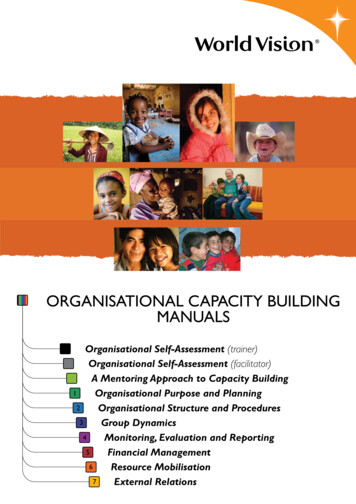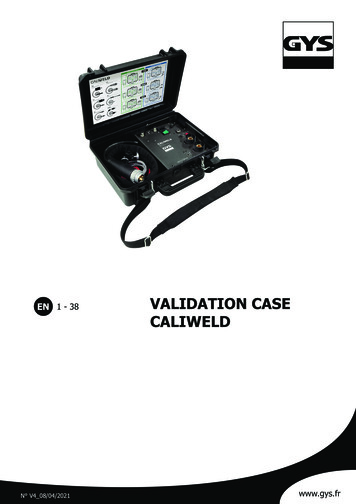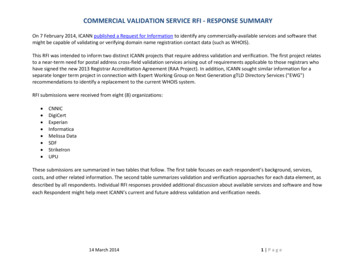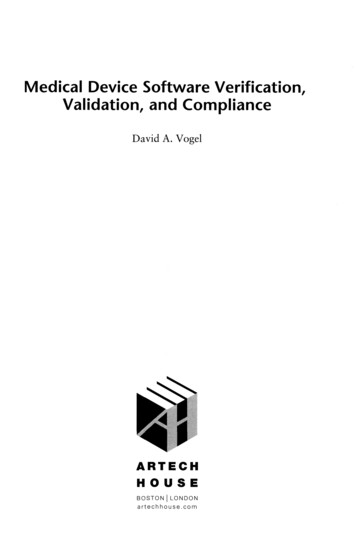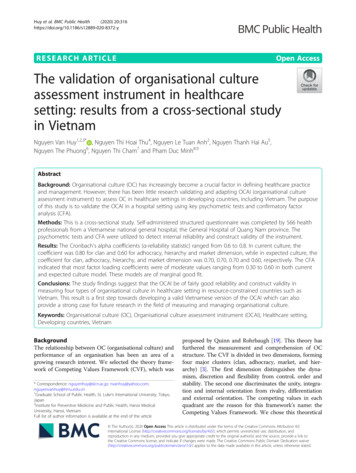
Transcription
Huy et al. BMC Public Health(2020) EARCH ARTICLEOpen AccessThe validation of organisational cultureassessment instrument in healthcaresetting: results from a cross-sectional studyin VietnamNguyen Van Huy1,2,3* , Nguyen Thi Hoai Thu4, Nguyen Le Tuan Anh2, Nguyen Thanh Hai Au5,Nguyen The Phuong6, Nguyen Thi Cham7 and Pham Duc Minh8,9AbstractBackground: Organisational culture (OC) has increasingly become a crucial factor in defining healthcare practiceand management. However, there has been little research validating and adapting OCAI (organisational cultureassessment instrument) to assess OC in healthcare settings in developing countries, including Vietnam. The purposeof this study is to validate the OCAI in a hospital setting using key psychometric tests and confirmatory factoranalysis (CFA).Methods: This is a cross-sectional study. Self-administered structured questionnaire was completed by 566 healthprofessionals from a Vietnamese national general hospital, the General Hospital of Quang Nam province. Thepsychometric tests and CFA were utilized to detect internal reliability and construct validity of the instrument.Results: The Cronbach’s alpha coefficients (α-reliability statistic) ranged from 0.6 to 0.8. In current culture, thecoefficient was 0.80 for clan and 0.60 for adhocracy, hierarchy and market dimension, while in expected culture, thecoefficient for clan, adhocracy, hierarchy, and market dimension was 0.70, 0.70, 0.70 and 0.60, respectively. The CFAindicated that most factor loading coefficients were of moderate values ranging from 0.30 to 0.60 in both currentand expected culture model. These models are of marginal good fit.Conclusions: The study findings suggest that the OCAI be of fairly good reliability and construct validity inmeasuring four types of organisational culture in healthcare setting in resource-constrained countries such asVietnam. This result is a first step towards developing a valid Vietnamese version of the OCAI which can alsoprovide a strong case for future research in the field of measuring and managing organisational culture.Keywords: Organisational culture (OC), Organisational culture assessment instrument (OCAI), Healthcare setting,Developing countries, VietnamBackgroundThe relationship between OC (organisational culture) andperformance of an organisation has been an area of agrowing research interest. We selected the theory framework of Competing Values Framework (CVF), which was* Correspondence: nguyenhuy@slcn.ac.jp; nvanhuy@yahoo.com;nguyenvanhuy@hmu.edu.vn1Graduate School of Public Health, St. Luke’s International University, Tokyo,Japan2Institute for Preventive Medicine and Public Health, Hanoi MedicalUniversity, Hanoi, VietnamFull list of author information is available at the end of the articleproposed by Quinn and Rohrbaugh [19]. This theory hasfurthered the measurement and comprehension of OCstructure. The CVF is divided in two dimensions, formingfour major clusters (clan, adhocracy, market, and hierarchy) [3]. The first dimension distinguishes the dynamism, discretion and flexibility from control, order andstability. The second one discriminates the unity, integration and internal orientation from rivalry, differentiationand external orientation. The competing values in eachquadrant are the reason for this framework’s name: theCompeting Values Framework. We chose this theoretical The Author(s). 2020 Open Access This article is distributed under the terms of the Creative Commons Attribution 4.0International License (http://creativecommons.org/licenses/by/4.0/), which permits unrestricted use, distribution, andreproduction in any medium, provided you give appropriate credit to the original author(s) and the source, provide a link tothe Creative Commons license, and indicate if changes were made. The Creative Commons Public Domain Dedication o/1.0/) applies to the data made available in this article, unless otherwise stated.
Huy et al. BMC Public Health(2020) 20:316model for a variety of reasons. First, it is an evidencebased framework as it was developed based on researchshowing both face and empirical validity. Second, the CVFcan fit diverse types of organisational settings and is utilised to measure types, congruence, and strengths of OCusing commonly associated terms: the core culturalvalues, interpretations and assumptions that characteriseorganisations [3]. It also provides a framework for studying and understanding OC that can reflect a mixture ofmultiple cultural types as well as diverse characteristics ofa particular cultural type [6, 8, 13]. Last, but not the least,as OC tends to develop over time with the adaption andresponses of members to the environment, the CVF is aconceptual foundation that can fit a variable context andas a result be applied for research and facilitation of OCchange and OCAI being discussed below is among thetools developed from such a framework [19].Clan Culture (CC), which is identified by the flexibilityand internal focus aspects of the CVF, is typical of afamily-style organisation with a friendly working environment. Leaders play the role of mentors and facilitators.Employees are committed, and focus on the long-termbenefit of individual development. Teamwork, cohesion,and loyalty are important aspects of this culture. Adhocracy Culture (AC), characterised by the flexibility and external focus aspects of the CVF, is typical of a dynamicand creative working environment. Leaders are seen as innovators and risk takers. Employees accept the challenge,want to make a difference and can be seen as very aggressive, with a desire to lead. Commitment to experimentation and innovations, high specialisation and rapid changeof organisation are the key aspects of the Adhocracy Culture. The internal focus and stability aspects of the CVFare describe in Hierarchy Culture (HC), which is a seriousand organised work environment, similar to governmentalorganisations. Leaders are proud of their workplace andplay the role of coordinators, supervisors. Employees arehighly aware and compliant to the principles and procedures of the organisation. Stable development, efficiencyand control, rules and policies are the key aspects of Hierarchy culture. The last one - Market Culture (MC), whichis defined by the stability aspects and external focus of theCVF, is typical of a results-oriented workplace. Managersare hard-driving competitors and producers. Employeesfocus on success and achievement. The important aspectsof this culture are long-term concern for competitivenessand winning [3].To measure the current OC and its cultural preferences,Cameron and Quinn have developed the OrganizationalCulture Assessment Instruments (OCAI) based on the CVF.This instrument was created in order to measure the OC aspects in the present situation and to meet the wishes ofemployees [3]. OCAI, a classification approach [12] was developed to evaluate OC with six core attributes: DominantPage 2 of 8Characteristics; Organisational Leadership; Management ofEmployee; Organisation Glue; Strategic Emphases; Criteriaof Success. The questionnaire includes 24 items divided intofour alternatives, which correspond with the four culturaltypes labelled Clan, Adhocracy, Market, and Hierarchy [3].Many studies still have limited evidence for validatingan instrument measuring psychology properties such asOCAI [5]. Previous studies used Vietnamese version ofOCAI to measure OC in Vietnam. However, it requiresmore effort than a literal translation to develop an acceptable instrument for another cultural group [11, 23].Most of these studies did not clarify the way of eachitem in the OCAI was translated and the translated version was validated by which methods. When the OCAIis used in a different country, culture and sample fromthe original instrument, its psychometric properties, including reliability and validity, have to be re-examined[7]. Unfitting translation processes could lead to biasedor misguided study outcomes [4, 15]. In addition, therehas been a growing need for standard and validatedpractices for a translated psychometric scale in a healthcare setting in developing countries such as Vietnam.Therefore, we conducted this study in order to validatethe OCAI in a healthcare setting as a first step towardsestablishing a valid a Vietnamese version of the OCAI.This study also serves as a valid basis for future studiesin the field of measuring and managing OC.MethodsStudy designThis cross-sectional design study employed quantitativeresearch methods and was conducted in Quang Namprovince’s General hospital from April 2016 to July 2017.ParticipantsAll health staffs working in the hospital were approachedfor data collection. Of 701 staff eligible for interview, 566people agreed to participate in the research, reaching aparticipation rate of 80.7%. The sample of 566 participantsmet the minimum power requirement for analysis.Research instrumentThe OCAI was chosen in this study [3] because it’s abilities of describing the culture depending on alignmentsand identifying the expected pattern between culturefactors and other organizational variables of interest. Inaddition, OCAI is one of the instruments can assess culture with demonstrated adequate internal consistenciesand evidences for aggregating individual data to be representative of the organisation as a whole [10].The OCAI developed by Cameron and Quinn [3]was translated and reworded to create an appropriateand comprehensive Vietnamese version. We employedself-administered questionnaire to collect data. Eligible
Huy et al. BMC Public Health(2020) 20:316participants were invited to the hospital’s meetingroom of and were introduced to the purpose of thisstudy as well as the instrument. Researchers ensuredthe privacy of the meeting place and no exchange ofinformation among participants was allowed duringthe survey. All questionnaires were completed by participants and transferred to research team.Key measures and data analysisThe six attributes of OC, Dominant Characteristics, Organisational Leadership, Management of Employee, Organisation Glue, Strategic Emphases, Criteria of Success,were evaluated by using OCAI with 24 items [3]. Withineach component, there were 4 statements, each of whichrepresents one type of OC. Participants were asked to distribute 100 points between 4 statements to indicate theirorganisational relevance. First they were asked about culture perceptions of their current organisations by 24 itemquestions/statements. Respondents were then asked againbut for their ideal or expected organisational practices.After all steps, 24 items were regrouped to form 4 types ofOC, CC, AC, HC and MC, each of which had 6 statements. Because of its compromise, a higher score of onetype of OC means a lower score of another one.The instrument was assessed according to two main criteria, reliability and validity. The correlations between thefour dimensions of current and expected organisationalculture were tested to confirm the consistency of the CVFand that the data was appropriate for factor analysis.Cronbach’s alpha coefficients (α reliability statistic) werecalculated for all the culture types, and the internalconsistency indices were demonstrated as sufficient asthey ranged from 0.6 to 0.8 [3]. Two kinds of validity wereanalysed in our study, construct and face validity. Face validity was satisfied based on the results of two activities, apilot survey among 30 participants and a review by seniorresearchers involved in this study. There was no muchchange in instrument contents after pilot. To assess construct validity, CFA (confirmatory factor analysis) was utilized for both the current and ideal organizational culturedata. CFA was performed not only to assess construct validity, but also to refine measurement instruments. Construct validity refers to the extent to which an instrumentmeasures what it means to measure as defined by a theory[18]. The CFA was conducted two times using data of thecurrent and expected OC to evaluate whether the cultureconformed to the hypothesised OCAI model. The unidimensional models with all indicators loading onto a singlefactor then were used to assess the fit of the four-factormodel. Our data is suitable for factor analysis as weachieved a more-than-23-time ratio of our sample of 566participants over 24 OCAI items (the minimum requiredof at least 5 to 10 times the amount of items in the CFAmodel [14], most of the correlations were of statisticallyPage 3 of 8significant moderate levels and there were no outliers inthe data [22].Data was checked and entered by Epi data 3.1 and wasanalysed by using STATA 10.0. Prior to the analysis, allassumptions were tested to ensure the model fit by considering the value of χ2/df, Standardized Root MeanSquare Residual (SRMR), Comparative fit index (CFI) andRoot mean square error of approximation (RMSEA).AMOS version 20.0 was used to test model re-assessmentfor both current and expected cultural model that createdthe factor loading coefficients between each item and between dimensions.Research ethicsThis study was ethically and scientifically reviewed andapproved by Hanoi Medical University according to Decision No. 5403/QD-DHYHN dated 06/12/2016. All participants received information of the purpose andmethods and their right to refuse participation at anytime. We obtained their verbal informed consent as theprincipal investigator is currently working at this hospital and all participants agreed to support the study andas this study is part of research agenda of the hospital toimprove healthcare quality. They were re-affirmed thattheir participation was voluntary, that their anonymitywas maintained, and that their refusal would not affecttheir health care.ResultsThe selected socio-demographic characteristics of thesampleAmong the 566 respondents enrolled in the survey, majority are female (72.4%), quite young (mean age of 31.9years old) and married (80.7%). Most of respondentshave intermediate degree (39.4%), followed by collegedegree (33.6%) and university degree (27%). The ratio ofmanagers and staff is one-ninth (10.3 and 90.7%) andmost respondents having more than 5 years of workingexperience with workplace inside the laboratories.The reliability and validity of OCAITable 1 indicates that all correlations are consistent withthe CVF and statistically significant in both current andexpected culture. For instance, in the current culture,the correlation between the clan and adhocracy cultureis 0.44, clan and market culture is 0.39, clan andhierarchy culture is 0.43, adhocracy and market cultureis 0.10, adhocracy and hierarchy culture is 0.12, market and hierarchy culture is 0.29. In the expected OC,the correlations between dimensions are also significant,but most of the correlations are negative. The data istherefore appropriate for factor analysis.Means, standard deviations and Cronbach’s alphas foreach of the current culture factors and expected culture
Huy et al. BMC Public Health(2020) 20:316Page 4 of 8Table 1 Correlations of the OC DimensionsCultureCurrent OC1Expected OC231. Clan Culture–2. Adhocracy Culture 0.44*–3. Market Culture 0.39* 0.10*–4. Hierarchy Culture 0.43* 0.12* 0.29*41234–– 0.30*– 0.60*0.18*– 0.18* 0.50* 0.23*–*p 0.05factors are shown in Table 2. In general, clan cultureand market culture are favourably chosen by the participants for the present culture (Mean 26.60). At thesame time, participants chose clan culture as the expected culture for future workplace (Mean 31.50). EachCronbach’s alphas coefficient is satisfactory compared tonormal standards of reliability, statistical significantly. Incurrent culture, the coefficient is 0.80 for the clan culture and 0.60 for the remaining. In expected culture, thecoefficient for the clan, the adhocracy, the hierarchy, andthe market culture is 0.70, 0.70, 0.70 and 0.60, respectively. In other terms, respondents are more likely to ratetheir organisation’s culture consistently across the various questions on the instrument.Table 3 shows the results of CFA analysis for bothcurrent and expected culture data to assess the model fitindices. We tested all the prior assumptions and had themet results for conducting the analysis. The unidimensional models showed the χ2/df for both current and idealculture data is higher than three as a good model fit required. Therefore, the unidimensional models are notconsidered a good model fit for both current and idealdata. The CFA for the four-factor CC and EC data seemedto have a marginal good fit (χ2/df 3; SRMR varied fromten to 14; CFI was below 0.8, RMSEA 0.12 for EC).Figures 1 and 2 illustrated a model re-assessment forCC and EC model using AMOS version 20.0. As seen inthe CC data, the factor loading coefficients are in moderate correlation (0.3 β 0.5) except for Adhocracy two,Market two and Hierarchy two (β 0.27; β 0.22; β 0.28); the correlations between factors are negative; mostcorrelations between factors are moderate to strong. Regarding the EC data, the factor loading coefficients ofMarket two and Hierarchy two are under moderate (β 0.19; β 0.21). Most correlations between factors arestrong except for the correlations between Clan to Marketwhich are slightly weak. These results suggest the OCAIto be of fair construct validity.DiscussionTo our knowledge, this study is the first to validate theOCAI in healthcare setting in a developing country asVietnam. The study suggests that the Clan culture standsout to be the most dominant one in both current and expected culture, followed by the Hierarchy culture. The result shows the internally focus in organization, meaningthat the respondents highly prefer the value of internal stability rather than having a position in a competitive context,which is commonly in state organisations or governmentalorganizations. There was a dearth of research data on OCin Vietnam. We identified only one study on OC whichwas conducted in a local commercial joint stock bank,Sacombank, in southern Vietnam [17]. Our study is consistent with that study in that Clan culture was most expected, followed by other culture types. However, in termsof current culture, Phuong found that hierarchy culturewas reported as most commonly, while our study indicatesthat Clan culture remains dominant. This difference isunderstandable given different features between two settings – a for-profit, private economic entity versus a notfor-profit, public healthcare organization. To compare withother countries, our result is comparable with a studywhich administered the OCAI to 87 nurses [16] and another study with the measurement of OC at the Unitedstates [2]. Also, a study conducted in 7 research laboratoriesaffiliated with the University of Indonesia indicated thatTable 2 Means and Standard Deviations of Current Culture Factors and Expected Culture FactorsCulture typesMeanCCSDECCCMinimumECCCα ReliabilityMaximumECCCECCCECClan 70Adhocracy erarchy rket CC Current Culture, EC Expected culture
Huy et al. BMC Public Health(2020) 20:316Page 5 of 8Table 3 Comparisons of Fit Indices between the Unidimensional and Conventional Models of Current and Expected CultureFit cModelsCurrent CultureUnidFour factor246649.1.001Δ Unid - Four factor model97011.06.0000.1470.00.23.10Expected CultureUnid2527326.35.00018.40.17.22Four factor model246626.50.00114.00.80.12Δ Unid - Four factor model66699.85.000Note. aStandardised Root Mean Square Residual. bComparative Fit Index. cRoot Mean Square Error of Approximation. dUnidimensionalFig. 1 CFA Results for Conventional Four-Factor OCAI Model of Current OC
Huy et al. BMC Public Health(2020) 20:316Page 6 of 8Fig. 2 CFA Results for Conventional Four-Factor OCAI Model of Expected OCclan culture was the most common and was desired amongmember of research laboratory [1]. The CFA results of thisstudy suggest that Clan culture has the highest correlationwith the remaining culture, especially with the Market culture even though they lead in two opposite theoretical dimensions. All of the correlations were different from zero,even though there were a few implying weak relationshipsbetween these culture type factors. Thus, it could be saidthat the OC of hospital in Vietnam is the balance of all fourtypes of culture, with the dominant type being Clan culture.Such balance might be due to the natural essence of publichospitals in Vietnam. Clan culture was most preferred because the staff acknowledge the organization as their second family, where they can share the common goals andvalues with the expectation of being empowered by theirleaders. The trusting and dependent relationships betweenthe leaders and members of organisation also boost theadaptability, creativity and innovation of the hospital [20,21]. Apart from that, the public hospital, which was established and managed by the government, had to set out, to acertain extent, the principles and rules for the members toabide to. Market culture is also a dominant trait. Indeed,the current Government policy has been shifting the hospital financing from being subsidised to self-reliant, whichenables the organisation to set their own economic goals.Prior to our study, the validation of OCAI had beenconducted for the English version [9] and the Koreanversion [5]. Choi and colleagues validated the Korean
Huy et al. BMC Public Health(2020) 20:316version of OCAI by employing factor analysis and foundmoderate model fit with acceptable psychometric properties upon accepting a small sample size bias [5]. Meanwhile, Heritage and colleagues validated the use ofOCAI within the Australian context. By using CFA, thestudy came to a conclusion that good model fit was acknowledged for both current and expected cultures [9].The findings regarding the Vietnamese version of OCAIthat we used in this study show fairly good internalconsistency, which is demonstrated by high Cronbach’salpha coefficients, ranging from 0.6 to 0.8 in bothcurrent and expected culture. The results were on parwith the previous validation studies of OCAI [5, 9].Moreover, it also indicates that the four-factor modelhas a higher fit than the unidimensional model in bothcurrent and expected culture. Such view was shared bythe validation study in Australia [9]. However, only someof the CFA indexes demonstrated the fairly marginalgood fit of the same four-factor model for the application of OCAI in Vietnam health care settings. The results of CFA are also supportive of the fairly good fit ofthe model as the factor loading coefficients were inmoderate correlation (0.3 β 0.5) and some are undermoderate. The loading factor is lower compared to thestudy by Heritage and colleagues [9]. There are multipleexplanatory causes for the model getting only marginallygood fit. It could be due to the translation of OCAI tothe Vietnamese version used in this study. It came toour attention that the item two from CFA in both ECand CC had relatively poor fit in comparison with otheritems (Market two and Hierarchy two in EC and Adhocracy two, Market two and Hierarchy two in CC). Eventhough the translation was precise enough to carry thesame meaning as the English version, we suspect thatthere would still be dissimilarities between the translatedand the original content regarding the meanings andconcepts of the words. Indeed, in some cases, severalEnglish words have the same meaning as one Vietnamese word or vice versa. Apart from that, the mechanismof wording and sentence structure is also different between the two languages. Misinterpretation of even asingle word used in psychological instruments could create biases in the results or a methodological error thatcould have adverse effects on the findings of the studies[5]. Therefore, the Vietnamese OCAI version used inthis study might need further modification in order tohave smaller dissimilarities with the English version andbecome a more precise OC assessment tool in Vietnam.This study has some limitations that need to be considered when interpreting the results. Although efforts weremade to include a relatively large number of respondents,the sample of this study might not be representative forthe whole health care settings of the country. In addition,as the study was conducted in a public hospital, thePage 7 of 8respondents working here might consider their organisation to be more of a Hierarchy culture. Future researchmight need to take on a cross-national sample with respondents working not only in the public but also the private sector in order to have a better representation of thehealth care settings in Vietnam.ConclusionsThe Competing Values Framework (CVF), which originally proposed [19] and has advanced the measurementand comprehension of OC structure. Based on it, theOC Assessment Instruments (OCAI) was developed tomeasure the OC aspects in the situation of present andemployee’s wishes. Up to date, this instrument has beenapplied in different contexts around the world but inVietnam, there is only one study applying this instrument to assess the OC in the banking sector. Our studyaimed to validate the OCAI in healthcare setting of a developing country like Vietnam as a first step toward establishing a valid Vietnamese version of the OCAI and avalid basic for future studies in the field of measuringand managing OC. The results indicated that the OCAIhad quite good reliability with Cronbach’s alpha coefficients ranging from 0.6 to 0.8 in both current and expected culture. Regarding its validity, the translatedversion of OCAI showed a fairly good fit, with most ofCFA loading factors of less than 0.60. These findingssuggest that OCAI could be used to measure the OC.Future studies may also need to validate the OCAI indifferent sectors and settings.AbbreviationsCC: Current Culture; CFA: Confirmatory Factor Analysis; CFI: Comparative fitindex; CVF: Competing Values Framework; EC: Expected Culture;OC: Organizational Culture; OCAI: Organizational Culture AssessmentInstrument; RMSEA: Root mean square error of approximationAcknowledgementsWe acknowledge the administrative support from Quang Nam CentralGeneral Hospital, Vietnam. We appreciate the research team to help conductdata collection. We thank the participants for providing responses to thequestionnaire survey.Authors’ contributionsNVH and NTHA developed the proposal. NTHA conducted data collection.NVH analysed data and interpreted results. NVH, NTP, NTHT, NTC and NLTAdrafted the manuscript. NLTA revised the manuscript. NVH, NTP, PDM andNTHT critically revised the manuscript. All authors read and approved thefinal version of the manuscript.FundingThis study was self-funded by the authors. We did not receive any source offunding for this study.Availability of data and materialsThe datasets generated during and/or analysed during the current study areavailable from the corresponding author on the reasonable request.Ethics approval and consent to participateThis study was ethically and scientifically reviewed and approved by HanoiMedical University according to Decision No. 5403/QD-DHYHN dated 06/12/2016. All participants received information of the purpose and methods and
Huy et al. BMC Public Health(2020) 20:316their right to refuse participation at any time. We obtained their verbalinformed consent as the principal investigator is currently working at thishospital and all participants agreed to support the study and as this study ispart of research agenda of the hospital to improve healthcare quality. Theywere re-affirmed that their participation was voluntary, that their anonymitywas maintained, and that their refusal would not affect their health care.Consent for publicationNA.Page 8 of 811.12.13.14.Competing interestsThe authors declared no competing interests on the authorship andpublication of this article.Author details1Graduate School of Public Health, St. Luke’s International University, Tokyo,Japan. 2Institute for Preventive Medicine and Public Health, Hanoi MedicalUniversity, Hanoi, Vietnam. 3Department of Population and QuantitativeHealth Sciences, University of Massachusetts Medical School, Massachusetts,USA. 4Department of Health Management and Organization, Institute forPreventive Medicine and Public Health, Hanoi Medical University, Hanoi,Vietnam. 5Quang Nam General Central Hospital, Tam Hiep Commune, NuiThanh District, Quang Nam Province, Vietnam. 6Preventive Medicine, PublicHealth Student at Graduate School of Public Health, St. Luke’s InternationalUniversity, Tokyo, Japan. 7Training Center and Scientific Management,National Institute of Occupational Health and Environment, Hanoi, Vietnam.8Burnet Institute, 85 Commercial Road, Melbourne, Australia. 9Department ofEpidemiology and Preventive Medicine, School of Public Health andPreventive Medicine, Faculty of Medicine, Nursing and Health Sciences,Monash University, Melbourne, Australia.15.16.17.18.19.20.21.Received: 8 December 2019 Accepted: 18 February 2020References1. Akmaliah IF, Sensuse DI, Wulandari IA, Nurrohmah I, Imanda R, CahyaningsihE, Noprisson H. Analyzing knowledge management in research laboratoriesbased on organizational culture. In: Proceeding - 2017 3rd internationalconference on science in information technology: theory and application ofIT for education, industry and Society in big Data era, ICSITech 2017, 2018January; 2018. p. 278–83. https://doi.org/10.1109/ICSITech.2017.8257125.2. Bing-You RG, Varaklis K. Organizing graduate medical education programsinto communities of practice. Med Educ Online. 2016;21(1):31864. https://doi.org/10.3402/meo.v21.31864.3. Cameron, K. S., & Quinn, R. E. (2011).
of this culture are long-term concern for competitiveness and winning [3]. To measure the current OC and its cultural preferences, Cameron and Quinn have developed the Organizational Culture Assessment Instruments (OCAI) based on the CVF. This instrument was created in order to measure the OC as-pects in the present situation and to meet the .



